Sic transit Gloria Mundis
During the Communist era the lower part of Baile Herculane, where the river Cerna leaves its narrow valley, has been used to built mass tourism facilities. Employees and retirees could spend their state-allotted vacation vouchers there, hoping to improve their health. I have reserved a room in a hotel that has a pool. Daytime highs have soared to above 35 degrees Celsius and I am looking forward to a refreshing dip.
Many of the hotels are 8 to 12 story concrete structures with names like Hercules A, Hercules B, Afrodita, Minerva or Diana which try to compete for the skyline with the impressive limestone cliffs of the mountains surrounding the valley.
Paradise for the working class
My hotel is smaller. The very friendly lady at the reception gives me a room with a balcony on the forth floor. Indeed there are two pools. They are big, but the pool area basically is the extension of the even bigger parking lot. There is no single piece of green on the whole lot. The pools are surrounded by stretchers where the guests, many from outside who come here just to use the pool, bake in the sun. There are two different groups, families with little children and mostly overweight old people.
Again I have arrived covered in sweat. It is 3.5 km from the station to the hotel and against all warnings I have invested 20 Lei for a taxi. The friendly and honest driver points at the thermometer in the car. It shows 39.5 degrees. So I take a towel and go to the pool to freshen up somewhat. But when I take a dip into the water it is not refreshing at all. It is at least as warm as outside. Only after I get out, there is some relief due to the evaporation of the water from my skin caused by the wind. However, it isn’t much fun either to lie on one of the stretchers under a parasol to dry and cool. They are playing rap music of the type which makes you think the end of the world is near. An endlessly repeated tune of three notes is accompanied by a hammering bass and a text with the extensive if not exclusive use of different versions of the word “fuck”.
The weakly radioactive mineral springs of Baile Herculane have a natural temperature of 38-60 °C. Healing properties against a whole army of conditions like rickets, rheumatism, osteoporosis, cardiovascular and arthritic diseases as well as neurological, dermatological or pediatric conditions are attributed. That is why, regardless of their size, most of the hotels and pensions in Baile Herculane have a mineral pool or bath. Some people also take a dip in the river or in a makeshift pool dammed off the river. It seems much more refreshing to me.
Along the road in this part of town stalls or makeshift shops sell what is thought to be needed or coveted by the type of tourists visiting the spa. There is colorful bathware, towels, all kinds of plastic toys for children, gemstones, false jewelry, fridge magnets and the like. In between old women have spread out their goods on the pavement of the sidewalk. They try to sell their own produce, honey, cherries, vegetables or self made raki and vegetable oil.
I look for a restaurant. They are lined up along the main street. Most advertise pizza. Not far from my hotel there are two facing each other across the street. Both have a band playing traditional fast gypsy music. Both bands play as loud as they can. It is like a fight between the restaurants. On the sidewalk you are in between and if you stand in the right direction than each ear gets a different tune. The tunes mix in your brain into a cacophony which makes you dizzy. I try to get away but the combined sound of two different songs follows me up the road.
Number 1 of the competing restaurants
All the other restaurants play loud music as well. I sit down on the terrace of one where the noise seems to be a bit less. However, here it is a mixture from different sources. Several television screens blast out what seems mainly advertisements. Their sound mixes with what is broadcast from several speakers and appears to be the most popular of pop music.
But it can get worse. Just after I have finally attracted the attention of the waitress who persistently tries to disregard the three occupied tables she has to attend to and have succeeded to order my dinner and a beer, a band starts blasting off in the back of the establishment. It is amplified at full force. I try to form ear plugs from a couple of serviettes but have to find out that paper is quite unsuitable as a sound barrier. The blast is so loud that my ears start to hurt.
Restaurant interior
Both the music in the rival restaurants as well as the one where I am attracts dancers who move in a kind of circle. Most seem to be elderly, heavy and with an unhealthy color in their faces. Most also smoke, during the dance and while they have dinner.
Meanwhile I try to distract myself by observing the crowd outside. It is composed mainly of the middle aged to elderly tourist, clad in colorful shorts or sports leggings, the upper body dressed in something as colorful as possible and as reduced as possible to pronounce the massiveness of the bodily features. Red skin gives testimony of attempts to replace the unhealthy color by the color of a sunburn. While strolling up and down in slippers they inspect the abundant offerings of the stalls but mainly spend their money on cherries.
In 1933 the British author Patrick Leigh Fermor walked from the Netherlands to Istanbul. In the second part of the travelogue of this trip “Between the Woods and the Water”, which was only published in 1986 after Fermor had found back his diaries which had been stolen on the way, he recounts “suddenly and without any announcement a magnificent spa town appeared before me, which did not seem to fit into this wild valley”. He describes an old-fashioned spa built in the highly ornamented 18th century style of the Neo-baroque of the Austrian Hungarian empire with some few additions of a Romanian Neo-Byzantinism. A spa band played in an ornate pavilion. Finely dressed women with high heels strolled up and down the streets in the company of men looking like Rudolpho Valentino and were observed by officers in ornate uniform with high boots and clinking spurs.
That was what made me come here to see.
As usual I was early at the station of Turnu Severin to take the train to Baile Herculane. When I arrived the notice board announced a delay of 50 minutes. I sat down next to a woman and it turned out that she spoke German very well. She was on her way to Austria where she had work for three month in Innsbruck as a nurse. Most of the trip between somewhere in Hungary close to the border was covered in a company bus of the outsourcing agency she worked for, but to get there she took the train.
When I told her that my destination was Baile Herculane she became enthusiastic. It was her favorite place and she goes there every year for the healing power of the mineral water. She also raves about the local cuisine there.
Station Baile Herculane
She works in Austria but she loves her country. She owns a house and a big orchard with 50 fruit trees and loves to be alone to work in her garden. She wouldn’t like to share those moment in the morning, she says, when she gets up, has her coffee and enjoys the silence.
I start noticing a bit of a smell of raki in the air. The guy next to us listens to chinese pop music probably from tik-tok. We start getting a bit restless because after the announcement board had increased the delay of our train to 75 min it now had disappeared from the display altogether. I go inside to have a look but the displays inside also have forgotten our train. There is nobody to ask. The information counter is closed.
Arriving train Baile Herculane
The phone of my interlocutor rings. She chats a bit in Romanian, then hands the phone over to me. It is her boy-friend, a funny looking, friendly guy. He is a truck-driver and is on his way driving his 43 ton truck from Germany to the Netherlands. Grain. He speaks next to perfect German. He has worked in Germany now for 14 years and before had been in Italy for 9 years. Before he hangs up he tells me to beware of all those Romanian pick-pockets. Then she tells me that she only sees him for 10 days in summer. That is enough. She wants to be alone. Two years ago, on May 8th, her daughters and husband died in a car accident.
An announcement promises that our train will arrive soon. She says farewell and warns me to be careful with the taxi drivers. Then we board.
The train line from Drobeta Turnu Severin to Baile Herculane follows the Danube until Orsova. This stretch is called the Iron gate. For the ships on the river it was a nightmare. Cliffs of up to 500 m height on both sides forced the river into a gorge as narrow as 150 m with dangerous currents. A parallel road was hacked out of the vertical cliffs. Several Roman emperors from Tiberius to Trajan were busy building this road to allow troop movements for their Dacian wars. When it was finished emperor Trajan had a stone plate installed above the road showing dolphins and an inscription memorizing the completion of the road and the victory in the Dacian campaign.
When Patrick Leigh Fermor walked along here in 1933 he visited the stone plate, the village of Orsova and an island in the river, where a small group of ethnic Turks had survived for a century after the Turkish retreat. It is all gone. Between 1972 and 1984 the hydroelectric dams Iron gate I and II turned the Danube river downstream of Belgrade into a series of artificial lakes. The old village of Orșova Fermor had seen, at least 5 other villages and the Danube island of Ada Kaleh disappeared. The inhabitants had to move. Emperor Trajan’s memorial plate was relocated to a spot higher up and can be visited on boat trips.
The building of the dams also had a serious consequence for the fish population, in particular the sturgeon, since the fish were not able to move upstream for spawning any more. However, the danger for shipping on the Danube in this area was eliminated and there was enough electricity for the intended industrialization of Yugoslavia and Romania.
After the Habsburgs conquered the area from the Turks in 1789 the village of Orsova became the Danubian frontier of the k & k empire. Later, until the end of world war I it was the boundary to their newly found south eastern neighbor Romania.
Mouth of Roman aqueduct
It was known that already the Romans had enjoyed the hot thermal springs in the valley of the Cerna. They had built baths here with several pools, an aqueduct and an amphitheater with an outer diameter of 47 m.
The Habsburgs, very fond of spending their time and money in spa resorts, started a massive building program in what they would call – in memoriam of the Roman origins – Herkulesbad. In fact, several statues of Hercules were found at the archaeological site. When the area got under Romanian Rule in 1918 this would become Baile Herculane.
In my quest for discovering the remainders of this luxurious resort I start wandering upstream along the roads straddling both sides of the river. Several foot bridges cross the river and I choose the road along the left bank because there is less traffic. Modest family homes and a couple of simple guesthouses line the street. Some old people sit on benches in the shade. When I wave at an elderly women in an apron she greets back in German.
Main square old Baile Herculane
It turns out that she is the descendant of those German immigrants who were invited to settle in Transylvania in the middle ages. In the 1980’ies the German government paid for a generous relocation program and her children moved to Germany. By chance they live in the town where I come from. She goes there for several month each year.
Times have changed. She gives me instructions where I can find the past.
When the Habsburg architects started building the resort they reused the remaining Roman structures. Building material was recycled into the new buildings but the layout of the antique spa still comes back in the center where the rectangular park with terraces and the band stand, which still exists today, is built on the circumference of the antique Roman amphitheater. Next to the ornamented band stand there are two big circular fountains. One is actually working.
The spa park is topped by the former casino. The facade of the building and the colonnaded wings to the left and right are renovated. However, the building itself is empty. The cafe under the colonnade plays loud music to attract customers but is empty. The hall in the ground floor can be used for receptions and parties.
Colonnaded walkway at the casino
Next to the spa park is the ruin of hotel Traian. The windows are broken, parts of the stucco facade have fallen of and the makeshift roof of corrugated iron and plastic sheets is making rattling noises in the wind. The whole structure is fenced off the street to prevent parts from falling on passers-by and cars.
Across the street is the Elisabeth Villa from 1875. The famous resort was visited over time by many of the great personalities of the time including emperor Joseph II, emperor Francis I and empress Carolina, emperor Franz Iosef and empress Elisabeth. The latter couple we already have met in their Austrian summer retreat of Bad Ischl (part 4). In 1852, that is before he got his property built in Bad Ischl, the Emperor of Austria considered the Herculaneum Baths to be "the most beautiful resort on the continent".
Empress Elisabeth (Sisi) writes about the baths in her diary. In 1887, she stayed in the Elisabeth Villa to write poetry. When walking in the mountains with a friend she met a shepherd. As documented by a birth certificate, Sisi became the godmother of the daughter of the shepherd and gave them a ruby ring as a present. It was kept in the family for generations.
Between the ruins of Hotel Traian and the river is five star Hotel Versay. It is the only renovated structure at the center of the spa which is actually in use. There is a pleasant river-side outdoor cafe, but it is next to empty.
Hotel Versay
Across the street is what Fermor in 1933 must have seen when it was quite new: at the time it was the only recent building constructed in what he called Neo-Byzantine style, the hotel Cerna. It has its own baths. Both are painted in a painful yellow color. Maybe to increase their attractiveness. Next to it the Schimbarea la Față, transfiguration of Christ, orthodox church from 1863 in plain white.
In memory of the Roman tradition the various baths of Baile Herculane got Roman names. There is Neptune, Apollo or Diana. The most striking building of old Baile Herculane is Neptun, one of the former spa’s stretching along the river in several wings interrupted by domed pavilions. The gates are boarded up. The windows are lost. Along the basement a wooden structure provides shelter from fallen rubble. Weeds overgrow the remaining statues ornamenting the roof.
The baths of Neptun
A bridge was meant to give direct access to the baths of Neptun from the Spa park across the river. The metal structure is rust-covered, some of the planks of the floor have rotten away. It is closed for safety reasons and it is easy to see why.
The real center of the old town is a long square adorned with the statue of Herkules. It is a copy of one which was found in the Roman ruins of the site. The town square is crowned by the octagonal roman catholic church at the head of the square. Along the square former hotels and spas are lined up. There is hotel Ferdinand, which is closed. Hotel Hercules is empty but the facade has been renovated. Several buildings are covered in sheets as if the artist Christo would have a reincarnation here. Those facades which have undergone a facelift hide empty buildings. They have not yet found any use. There is a cafe, but few people. A pack of stray dogs rules the square.
At the end, to the right, are the baths of Apollo. They are open as a museum and you can get a slight impression of how the bath culture of the 19th century must have looked like. There are 2 bigger basins, but the client had the choice of individual, secluded cabins where they could immerse themselves in the healing waters unseen. Like in many parts of the old town there is an intense smell of sulfur allover the place.
Main square and baths of Apollo
The operators of the museum have tried to make it more interesting by panels exposing photos and CV’s of famous people who have been here. Although I cannot imagine that Kaiser Franz Josef or Sisi would have been satisfied with a dip in one of the small cabins.
An old guy at the entrance sells tickets, souvenirs and a book in Romanian. He speaks some German. I make a remark about the general state of old Baile Herculane. He answers that it was bad, but in 5 years everything will be renovated. I have my doubts.
The state of Baile Herculane is not the consequence of the communist rule in Romania. It is the consequence of the sale of the buildings to an investor in the year 2000. Those new owners did not invest in the conservation, let alone renovate anything. Degradation came quickly. However, a first initiative for restoration started in 2017 as a group of architecture students under Oana Chirilă began to collect money and took initial security measures. Since 2023, the spa town was included in the Europa Nostra funding.
Between the bridge across the river and the spa park is the enormous hotel Dezebal. They are busy with renovations. The facade of one of the wings is finished and it has got new windows. The building panel announces the termination of the works in 2027. It will become the new casino.
Băile Herculane is located in the Domogled-Valea Cernei National Park. It is the biggest Romanian national park and there are numerous possibilities for hiking. However, with temperatures of above 35 degrees it is far too hot for me. However, I want to at least do a little walk. If you continue upstream along the river the road follows the ancient Roman road. My intention was to visit a cave, Grota Haiducilor. It is above a little Spa next to the river which was already known by the Romans. A gaping hole is the end of the Roman aqueduct.
However, before I get there, I turn around a corner and in front of me a building like a craft from outer space blocks the view. The enormous Hotel Roman fills the valley. It is built across the old Roman road and what supposedly where Roman baths. The modern hotel also shows signs of degradation. The concrete has cracks, parts have fallen off and the paint is graying. But it is still in business.
Many other modern structures are abandoned and empty in Baile Herculane. At the entrance to the old town are the two towers of Hotel Hercules. The hotel, the club, the restaurant are all empty, windows broken, weeds grow.
The old buildings might get renovated. But who can give the money to dismantle huge structures like that? It will be interesting to come back in 5 years.
Sources:
Patrick Lee Fermor, Zwischen Wasser und Wäldern”, German translation, Fischer 2008
Herbert Rosendorfer: Herkulesbad. Eine österreichische Geschichte. München, Nymphenburger, 1985.
Link to previous post:







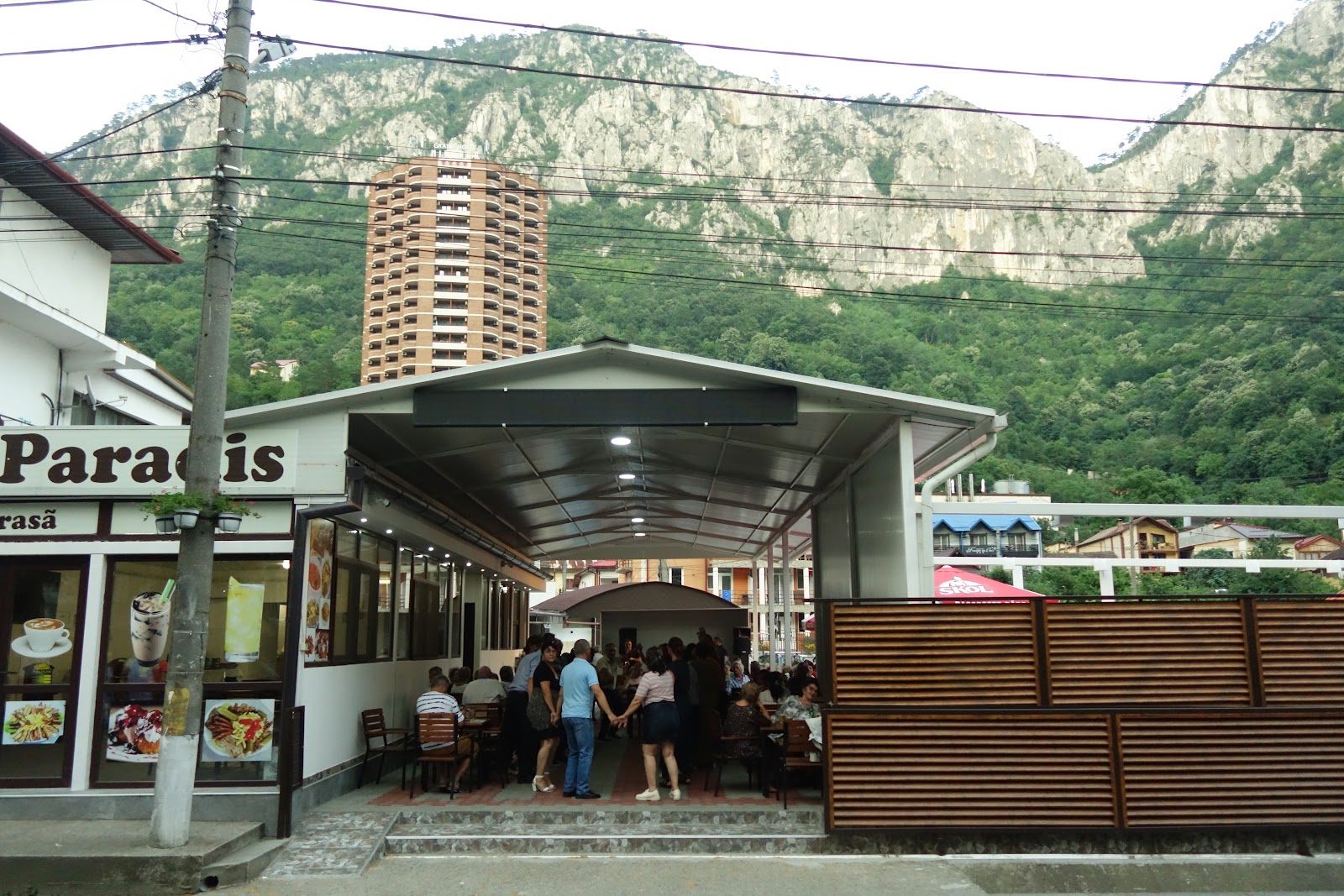


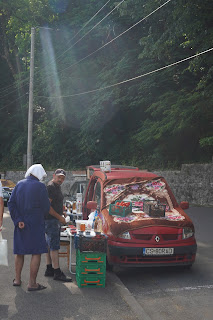






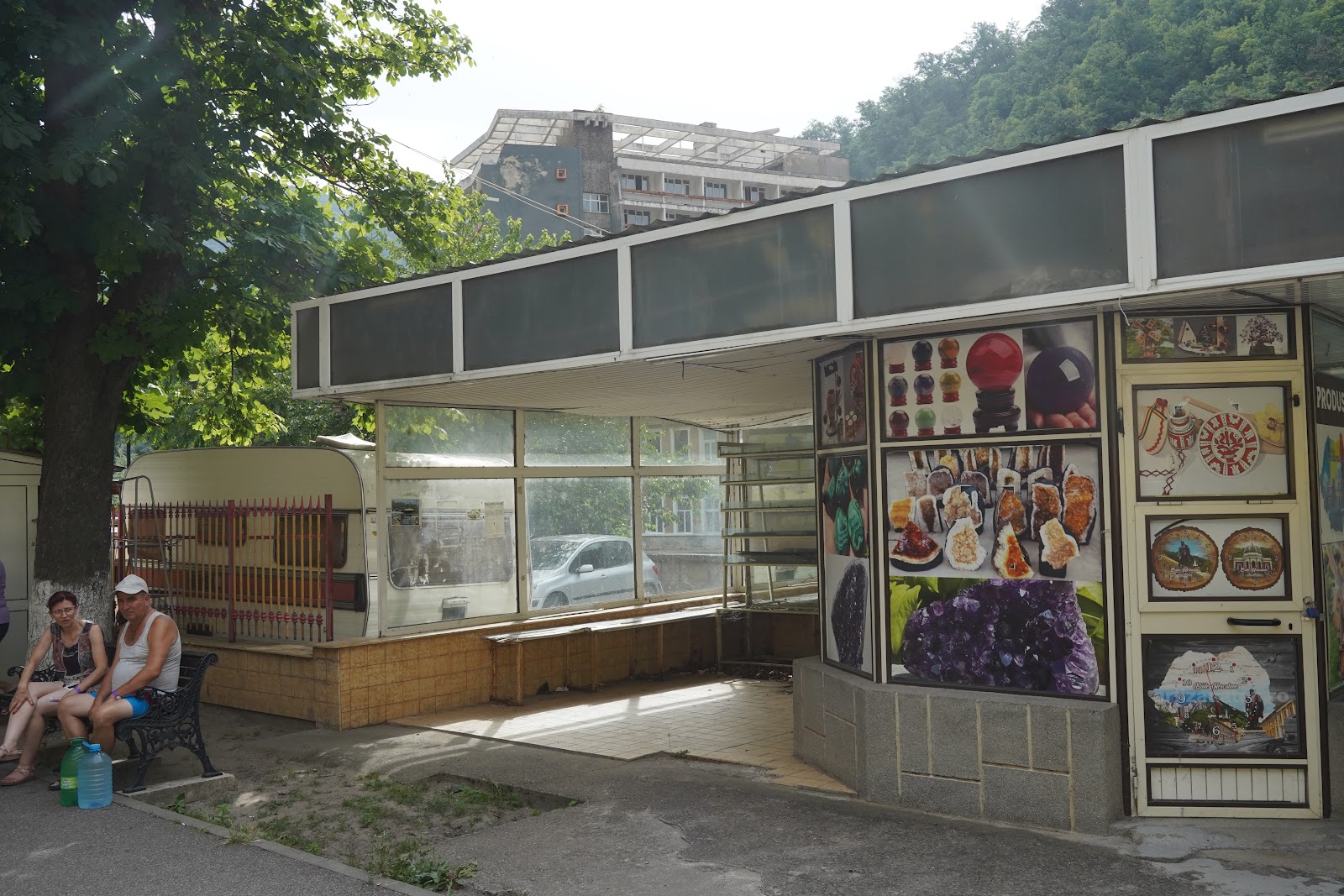



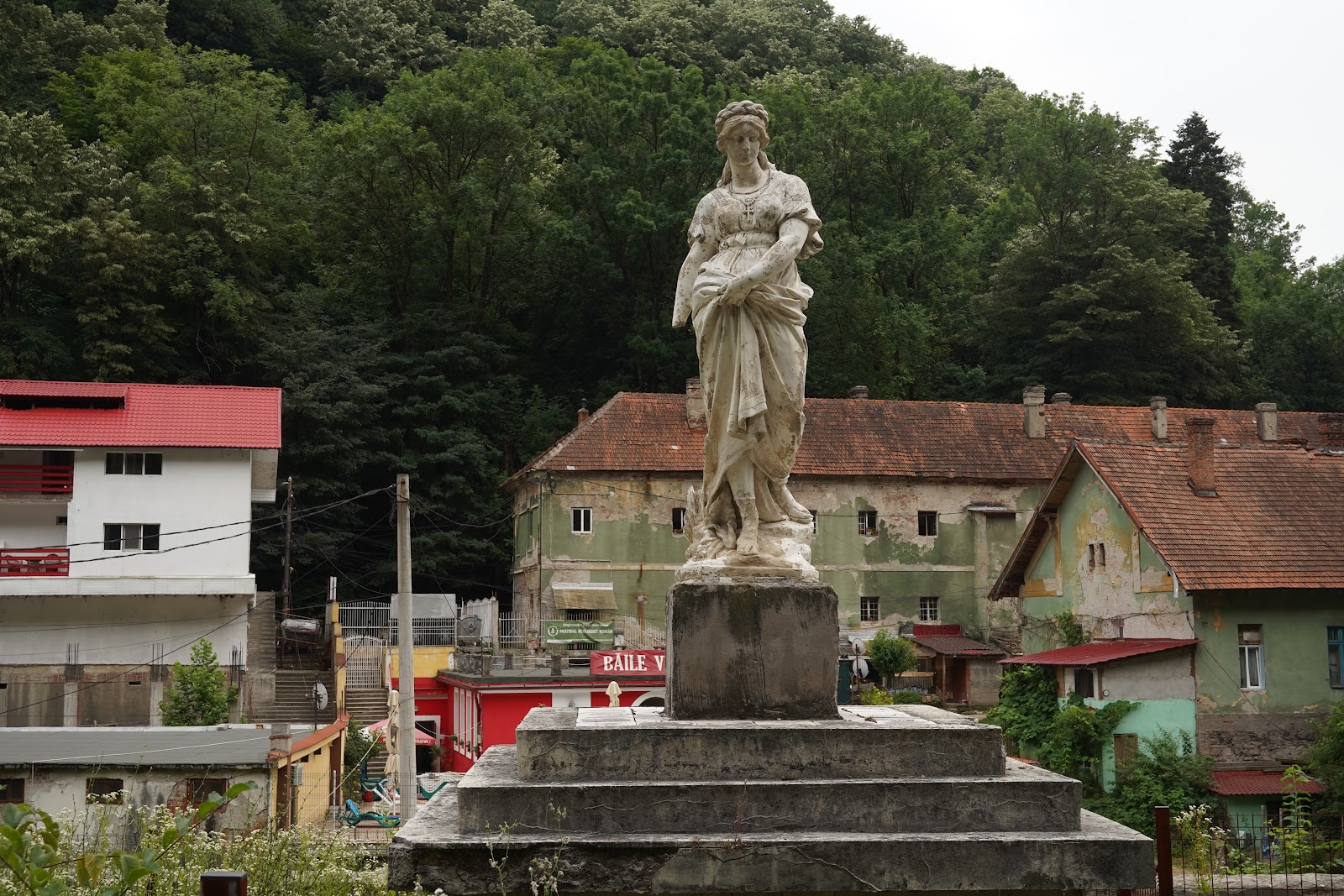










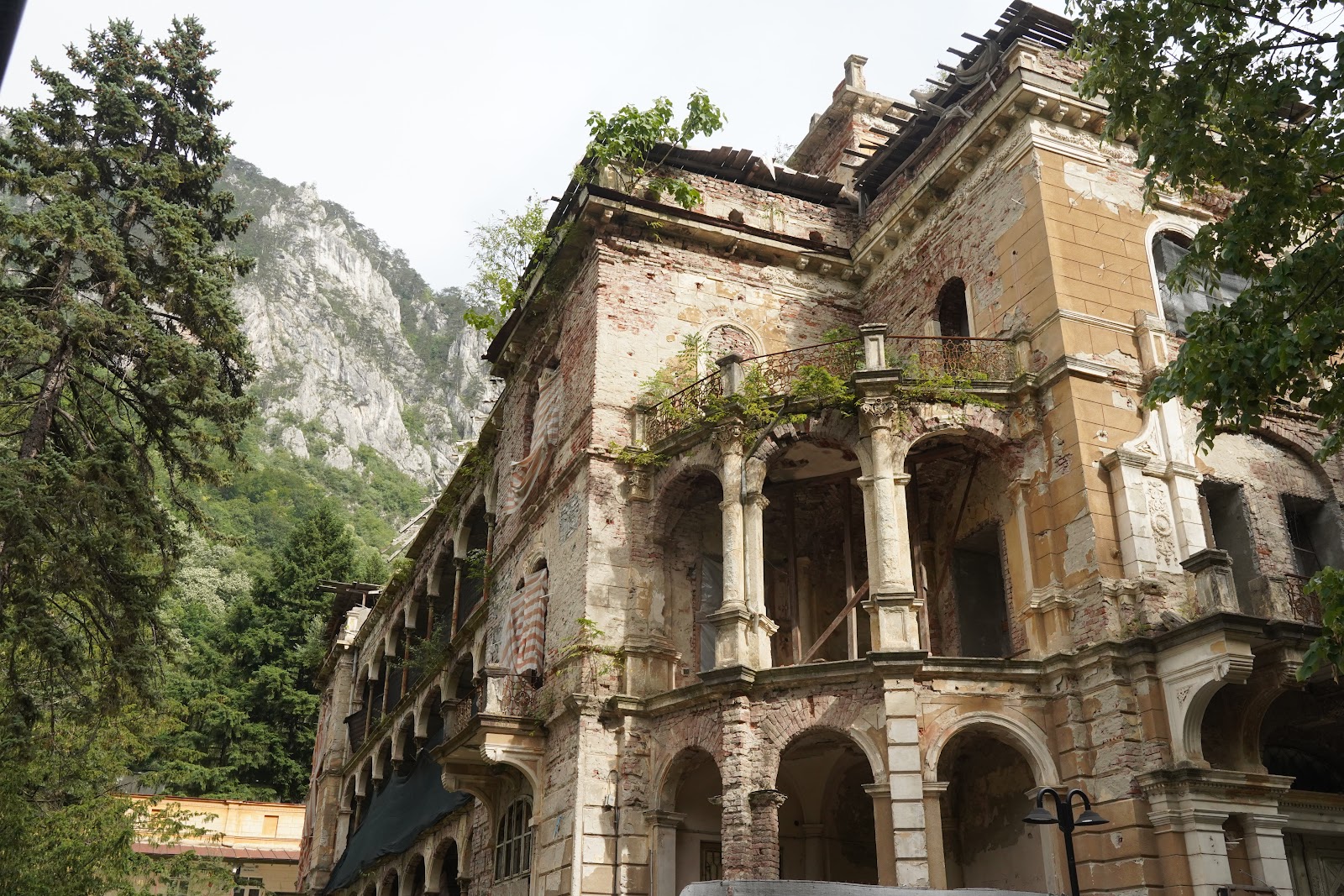







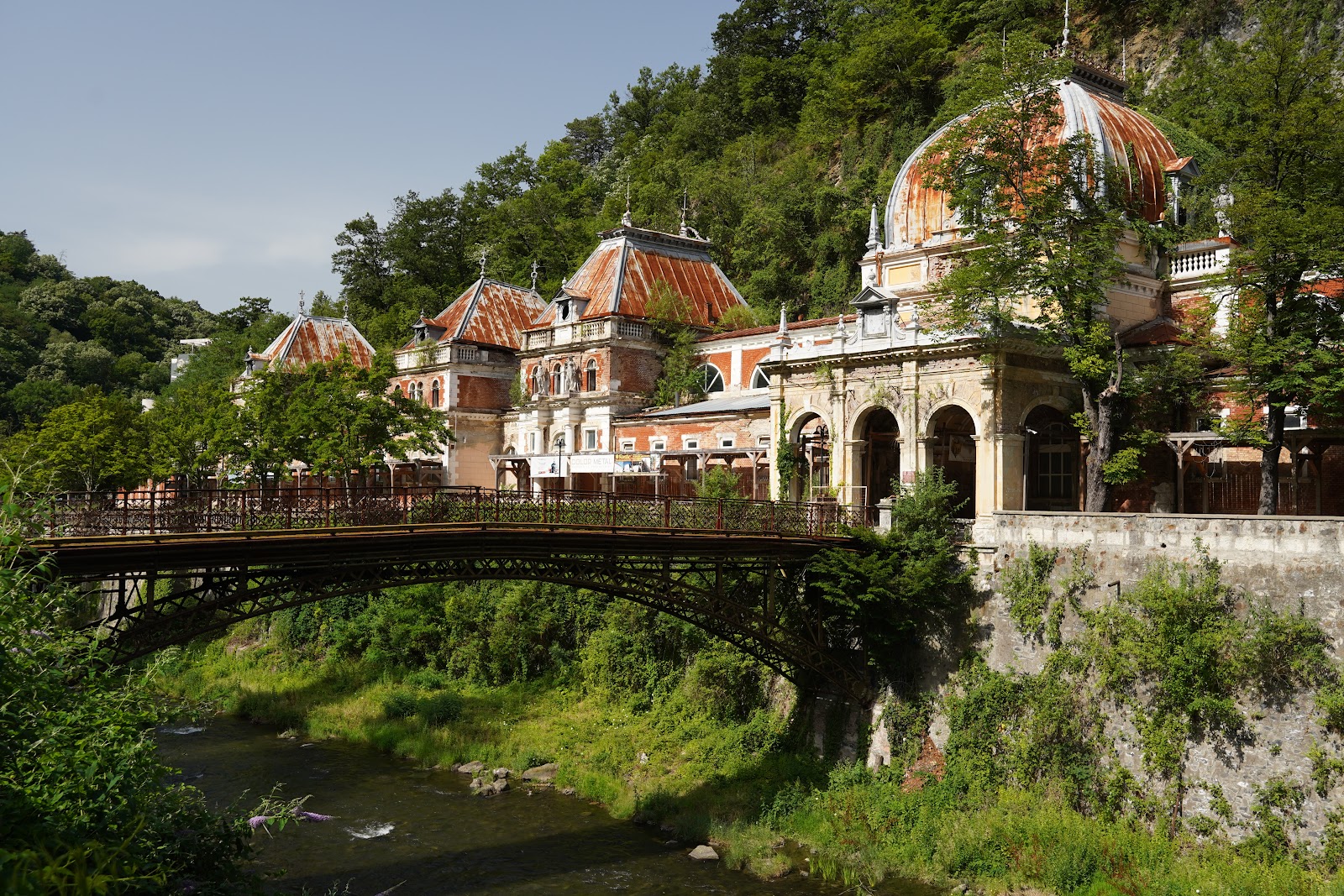



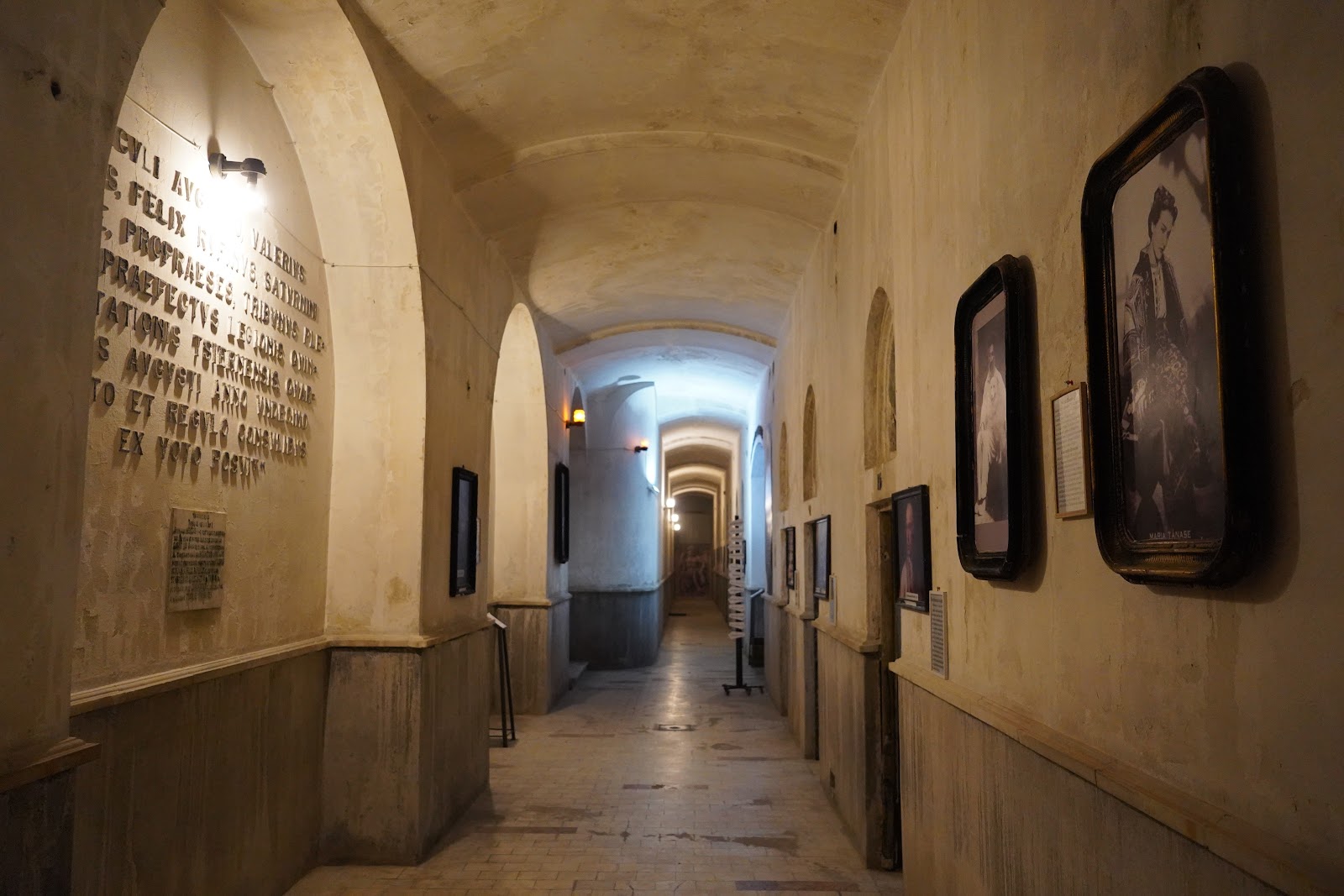










No comments:
Post a Comment